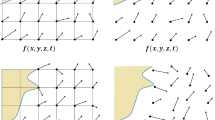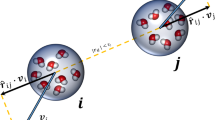Abstract
Laminar flows through channels, pipes and between two coaxial cylinders are of significant practical interest because they often appear in a wide range of industrial, environmental, and biological processes. Discrete particle modeling has increasingly been used in recent years and in this study we examined two of these methods: dissipative particle dynamics (DPD) and smoothed particle hydrodynamics (SPH) method when applied to (a) time-dependent, plane Poiseuille flow and (b) flow between two coaxial cylinders at low Reynolds numbers. The two examples presented in this paper give insight into different features of the two discrete particle methods. It was found that both methods give results with high accuracy, but CPU time is much larger (of order 102–103 in the second example) for DPD than for SPH model. This difference is due to the fact that the number of time steps for the DPD model is much greater than for the SPH model (since thermal fluctuations are taken into account in the DPD model).







Similar content being viewed by others
References
Albert R, Barabasi A-L, Carle N, Dougherty A (1998) Driven interfaces in disordered media: determination of universality classes from experimental data. Phys Rev Let 81/14:2926–2929
Belytschko T, Krongauz Y, Organ D, Fleming M, Krysl P (1996) Meshless methods: an overview and recent developments. Comp Meth Appl Mech Eng 139:3–47
Belytschko T, Lu YY, Gu L (1994) Element-free Galerkin methods. Int J Num Meth Eng 37:229–256
Davis ME (2002) Ordered porous materials for emerging applications. Nature 417:813–821
Dryden HL, Murnaghan FD, Bateman H (1956) Hydrodynamics. Dover, New York
Filipovic N, Haber S, Kojic M, Tsuda A (2008a) Dissipative particle dynamics simulation of flow generated by two rotating concentric cylinders. Part II: Lateral dissipative and random forces. J Phys D Appl Phys 41:035504
Filipovic N, Kojic M, Tsuda A (2008b) Modeling of thrombosis using dissipative particle method. Phylosoph Phil Trans R Soc A 366:3265–3279
Flekkoy EG, Coveney PV, De Fabritiis G (2000) Foundations of dissipative particle dynamics. Phys Rev E 62:2140–2157
Espanol P, Warren P (1995) Statistical mechanics of dissipative particle dynamics. Europhys Lett 30(4):191–196
Espanol P, Revenga M (2003) Smoothed dissipative particle dynamics. Phys Rev E 67, 026705-1-12
Gerstein M, Levitt M (2005) Simulating water and the molecules of life, Scientific American (The Water of Life, Special Issue), pp 24–29
Gingold RA, Monaghan JJ (1977) Smoothed particle hydrodynamics theory and application to non-spherical stars. Mon Not R Astron Soc 181:375
Groot RD, Warren PB (1997) Dissipative particle dynamics: bridging the gap between atomistic and mesoscopic simulation. J Chem Phys 107(11):4423–4435
Haber H, Filipovic N, Kojic M, Tsuda A (2006) Dissipative particle dynamics simulation of flow generated by two rotating concentric cylinders. Phys Rev E 74:1–8
Hoogerbrugge PJ, Koelman JMVA (1992) Simulating microscopic hydrodynamic phenomena with dissipative particle dynamics. Europhys Lett 19:155–160
Joseph PM, Fox PJ, Zhu Y (1997) Modeling low Reynolds number incompressible flows using SPH. J Comp Phys 136:214–226
Knutson CE, Travis BJ (2002) A pore scale study of permeability reduction caused by biofilm growth. Eos Trans AGU, 83(47), Fall Meet Suppl., Abstract H71B–0797
Kojic M, Filipovic N, Tsuda A (2008a) A mesoscopic bridging scale method for fluids and coupling dissipative particle dynamics with continuum finite element method. Comp Meth Appl Mech Eng 197:821–833
Kojic M, Filipovic N, Stojanovic B, Kojic N (2008b) Computer modeling in bioengineering: theoretical background. Examples and software. Wiley, Chichester
Landau LD, Lifshitz EM (1987) Fluid mechanics. Pergamon Press, Oxford
Liu M, Meakin P, Huang H (2007) Dissipative particle dynamics simulation of multiphase fluid flow in microchannels and microchannel networks. Phys Fluids 19:033302-1-11
Lucy LB (1977) A numerical approach to the testing of the fission hypothesis. Astron J 83:1013
Monaghan JJ (1994) Simulating free surface flows with SPH. J Comp Phys 110:399–406
Takeda H, Miyama SM, Sekiya M (1994) Numerical simulation of viscous flow by smoothed particle hydrodynamics. Prog Theor Phys 92(5):939
Tannehill JC, Anderson DA, Pletcher RH (1997) Computational fluid mechanics and heat transfer. Taylor & Francis, London
Vignjevic R (2004) Review of development of the smooth particle hydrodynamics (SPH) method, dynamics and control of systems and structures in space (DCSSS), 6th Conference, Riomaggiore, Italy
Wagner GJ, Liu WK (2003) Coupling of atomistic and continuum simulations using a bridging scale decomposition. J Comput Phys 190:249–274
Author information
Authors and Affiliations
Corresponding author
Rights and permissions
About this article
Cite this article
Filipovic, N., Ivanovic, M. & Kojic, M. A comparative numerical study between dissipative particle dynamics and smoothed particle hydrodynamics when applied to simple unsteady flows in microfluidics. Microfluid Nanofluid 7, 227–235 (2009). https://doi.org/10.1007/s10404-008-0379-0
Received:
Accepted:
Published:
Issue Date:
DOI: https://doi.org/10.1007/s10404-008-0379-0




